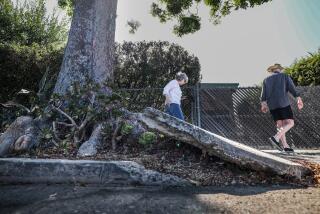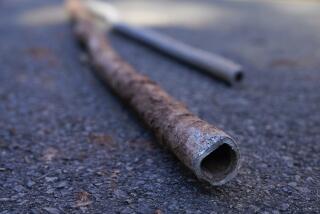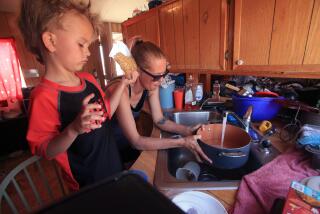The looming sinkhole crisis
- Share via
WHEN THEY SAW the recent pictures of a giant sinkhole in Guatemala, some folks in Los Angeles may have thought: “It could never happen here.”
They’re wrong.
The Guatemala City sinkhole that killed three people and swallowed dozens of homes was formed by the same thing that creates sinkholes in Los Angeles. Not weather. Not an act of God. Not strange rock. Bad sewer pipes created this sinkhole. And the problem is getting worse, around the world and in the United States.
Last year was the worst ever in the U.S. for sinkholes. Almost every state in the country experienced record problems.
In San Diego, the mayor held a news conference near a yawning abyss. A 64-year-old Brooklyn woman fell into a 5-foot-deep sinkhole in front of her house.
In Los Angeles, a broken water main created a sinkhole 30 feet deep and shut down half of Pacific Coast Highway near Malibu. At the same time, a broken sewer pipe shut down the adjacent beach.
In Northern California, an 8-foot-deep sinkhole stunned the occupants of a nearby office building. In Grand Rapids, Mich., residents had to boil water after a sinkhole cut off their water service.
And this year is shaping up to be even worse. From Hawaii to New York, Alaska to North Carolina and everywhere in between, an epidemic of breaking pipes is causing unprecedented havoc.
Yet for all this damage, few people understand how broken pipes create sinkholes. Most water and sewer pipes in the United States were built 60 years ago — but were meant to last 50 years. Do the math. Pipes are breaking as they get older.
When pipes break, two things happen: Water or sewage gets out, and water or dirt gets in. Havoc results when dirt enters a broken pipe and is whisked away, as though on a magic carpet ride. Soon, even if only by a spoonful a day, the dirt disappears from above the pipe and below the sidewalk — or below the road, park, building, etc.
We also know that rainwater entering broken pipes can overload sewage systems, causing even more sewage spills. Rain, though often cited as the culprit in sewage spills, is frequently just an innocent bystander.
Even when bad pipes don’t lead to a sinkhole catastrophe, they can cause major problems. The Environmental Protection Agency estimates that last year 3.5 million people became ill from E. coli and other toxins released from 40,000 sewage spills. A study last year by UCLA and Stanford University found that, every year, bacterial pollution in ocean water off beaches, much of it coming from broken pipes, makes 1.5 million people sick in Southern California.
Pipes are not that hard to fix anymore. With video cameras to find the leaks and new trenchless technology to fix them without the need for digging up streets, there is only one reason why so many broken pipes are forming so many huge sinkholes: We are not paying attention.
This may be changing. Mayors in Atlanta, Pittsburgh, San Diego, North Kansas City, Mo., and other cities are making sewage and water pipe repair a top priority.
That’s the good news. The bad news is that the pipes are getting worse faster than people are catching on.
*
THOMAS ROONEY is president and chief executive of a large sewer, water and oil pipe repair company.
More to Read
Sign up for Essential California
The most important California stories and recommendations in your inbox every morning.
You may occasionally receive promotional content from the Los Angeles Times.










